
Mold isn’t just something unsightly growing in the corner of a damp room—it can quietly cause serious damage to both your home and your health. Often thriving in areas with excess moisture, poor ventilation, and limited light, mold can go undetected until it becomes a much bigger problem.
Identifying the warning signs early is essential to avoiding costly repairs and potential health concerns. Here are key indicators that mold could be affecting your home or well-being:
1. Discoloration on Walls or Ceilings
Dark spots, patches, or staining—especially in bathrooms, basements, or near the roof—can be a red flag. These marks often signal hidden moisture and potential mold buildup behind the surface.
2. Persistent Musty Smell
A lingering earthy or stale odor, even in clean spaces, is one of the most common signs of hidden mold. It’s usually strongest in enclosed or poorly ventilated areas.
3. Aggravated Breathing Problems
If you or your family members notice worsened asthma, coughing, sneezing, or allergy symptoms at home, airborne mold spores could be the cause. These irritants often affect individuals with sensitivities the most.
4. High Indoor Humidity
A space that feels constantly humid or damp may be an ideal breeding ground for mold. Using a hygrometer can help monitor indoor moisture, which should stay below 60%.
5. Moist Fabrics or Wood
Carpets, curtains, upholstery, and wooden items that feel damp or musty to the touch may be harboring mold colonies. These materials tend to absorb moisture and retain it over time.
6. Mold Growth You Can See
Fuzzy, slimy, or discolored patches—typically black, white, or green—often appear in corners of bathrooms, near sinks, or along windows. Visible mold means active growth.
7. Bubbling or Cracked Paint
Peeling, bubbling, or cracked paint is often a sign that moisture is seeping behind walls. Mold often follows this damage.
8. Colored Spots on Damp Areas
Green or black specks on damp walls, bathroom tiles, or basement surfaces often point to the formation of mold colonies.

9. Eye, Nose, or Throat Irritation
Itchy eyes, sneezing, or throat discomfort that’s worse indoors but improves outside the home may be linked to mold exposure.
10. Chronic Nasal Congestion
Persistent stuffiness, sinus infections, or facial pressure that doesn’t respond to typical treatments could be a reaction to mold in your environment.
11. Recurring Headaches
If you experience unexplained headaches, particularly when indoors for long periods, it might be due to mold-related toxins in the air.
12. Moldy Smell on Belongings
If clothes, books, or stored items smell stale or moldy, it likely means mold spores are present in your home and attaching to porous surfaces.
13. Evidence of Water Leaks
Water stains, pipe leaks, or roof damage often go hand in hand with mold growth. Mold tends to follow wherever water has been.
14. Heavy, Stagnant Indoor Air
A room that feels dense, musty, or has poor air movement can signal elevated mold levels and insufficient ventilation.
15. Skin Irritation or Rashes
Unexplained skin issues such as itching or rashes that improve when you leave the house may be connected to mold exposure.
Take Immediate Action
If you recognize any of these warning signs, it’s important to act quickly. Mold spreads fast and can severely damage your home while impacting your health over time.
Consult a mold removal expert, increase airflow in your space, and consider using a dehumidifier to maintain ideal humidity levels.
Addressing mold early is key to protecting your home, your health, and your peace of mind.

















